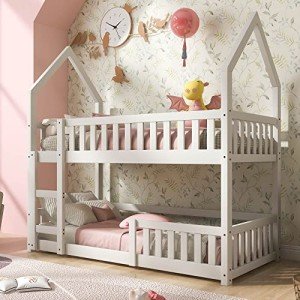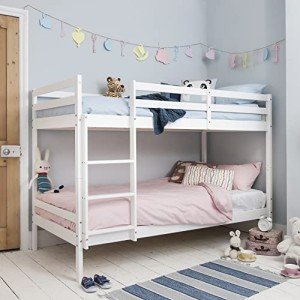Why Bed Bunk Wood Is Everywhere This Year
페이지 정보
작성자 Eddy Tenney 댓글 0건 조회 25회 작성일 25-01-18 14:17본문
 Kinds Of Bed Bunk Wood
Kinds Of Bed Bunk WoodWooden bunk beds provide a classic aesthetic that is a great suitable for numerous bed room styles. They are likewise tough and lasting, making them a great alternative for AirBNB or VRBO rental homes.
Preferably the bunk bed slats would be made from difficult birch or maple so they withstand flexing and won't warp. Soft pine is OK however may be prone to sagging with time.
Hardwoods
Understood for their strength and durability, woods are the most typical type of wood bunkbeds utilized in bunk beds. They are also the most costly, though they offer exceptional quality that will last a long period of time. In addition to being sturdy and long lasting, they are likewise visually pleasing and can be improved with a range of discolorations and surfaces.
Depending upon the species of tree, woods can vary in hardness, but usually they are harder and more resistant to rot than softwoods. In addition, their cellular structure is more complicated, which leads to them having a higher density. However, this is not a strict rule, as balsa wood-- which is one of the softest types of wood bunk beds twin over full-- is categorized as a hardwood due to its botanical category.
When choosing bed bunk wood for your project, it is necessary to consider the type of work you will be doing in addition to the designated application. Softwoods are normally more flexible than woods, which makes them a great option for furnishings and other light-duty applications. For more long lasting and heavy-duty applications, you will want to choose a wood such as oak, maple or cherry.
While these types of woods are known for their resilience, they are more tough to deal with than other types of lumber. In addition, they are more vulnerable to humidity, which can result in warping and other problems. For this reason, it is best to select a wood that has been effectively treated or sealed.
Wooden bunk beds are usually crafted from woods such as pine, maple or oak. These kinds of wood are frequently considered to be the most attractive, as they can be finished in a variety of ways. They are also really resilient and can hold up against the weight of the bed and the tension of use. However, wood can be harder to assemble than other kinds of bunk beds and might need professional installation.
For a more light-weight option, you might consider using plywood. This product is affordable, however it is not as strong as solid wood. It is also not as durable as metal, so it is not a good option for a bunk bed.
Plywood
Plywood is a type of crafted wood product that integrates real-wood veneers with other materials like medium density fiberboard (MDF), or oriented strand board (OSB). It's one of the most common structure materials utilized in modern-day building and construction and is also known as a multi-ply composite material. It's available in a wide variety of densities and sizes that permit it to be made use of within several types of structure jobs.
Plywood can be made from different species of trees, consisting of pine or birch. The kind of tree utilized will typically depend upon the specific purpose and level of resilience wanted for the plywood. For example, a plywood that is used for structural purposes will usually be sourced from hardwoods such as oak or maple. These types of woods are thought about to be more powerful and more long lasting than softwoods such as pine or fir.
Since the structure of a bunk bed is based on toughness and security, it's essential to guarantee that the wood used to develop the frame has the ability to stand up to the weight of an individual laying on the top bunk. Plywood is an ideal option for this since it can endure a great deal of pressure without flexing or warping under the pressure.
Another advantage of using plywood is that it can be built with a variety of different finishes and colors. This makes it simple to match the bunk bed with other furnishings pieces in a room, producing a cohesive and gorgeous appearance. Furthermore, using plywood is more environmentally friendly than using solid-wood materials. This is since fewer resources are required to make plywood, which minimizes the ecological impact.
 In addition to being strong and attractive, plywood is fairly affordable and easily available. This makes it a budget friendly option for developing a bunk bed, specifically when compared to a wooden bunk bed made from solid-wood. It's crucial to bear in mind, nevertheless, that solid-wood beds are more most likely to experience splintering and breaking with time than those developed from plywood.
In addition to being strong and attractive, plywood is fairly affordable and easily available. This makes it a budget friendly option for developing a bunk bed, specifically when compared to a wooden bunk bed made from solid-wood. It's crucial to bear in mind, nevertheless, that solid-wood beds are more most likely to experience splintering and breaking with time than those developed from plywood.For this reason, we advise selecting plywood for bunk beds that are meant to be utilized by children. Having a solid wood bunk bed can be more expensive than a plywood bunk bed, but it's worth the additional cost for a strong and lasting bed that will last years to come.
Poplar
In spite of being thought about a soft wood, poplar is very versatile and resilient. It's utilized to make a range of products, including furnishings, cabinets, and wooden toys. It's also a popular option for making plywood.
Poplar is a fast-growing tree that produces long, straight boards that are free of knots. It's likewise a "clear" wood futon bunk bed, indicating that it takes spots extremely well. Since of this, it's an excellent alternative for windows and door trim. It's also a popular choice among do-it-yourselfers because it's easy to work with and low-cost. It also takes screws and nails rather well.
Another thing that makes poplar a good option for bunk beds is the truth that it's really tough. It can hold up against a lot of weight without any concerns. That's since it has a fantastic strength-to-weight ratio. It's likewise a thick wood bunkbeds, which includes to its toughness.
In addition to its structural homes, poplar is also extremely light-weight. That makes it perfect for bunk bed frames and other types of furnishings. It's also really resistant to water and rot. It's essential to keep in mind, nevertheless, that poplar is not as strong as some other hardwoods, like hickory or red oak.
Bunk beds can be made with a variety of products, consisting of metal frames and solid wooden bunk beds - click through the next website page, platforms. They can likewise be developed with slatted foundations. Despite the type of frame you pick, it's crucial to utilize a bunk board to support your mattress. Without one, your mattress might sag too soon.
A bunkie board is a 1 to 3-inch flat barrier that fits between your mattress and the surface it rests on. Bunkie boards are a popular supplement for standard beds that were designed with innerspring mattresses in mind and may not work with foam or hybrid mattresses. They're likewise a great option if your slats are too far apart to support your mattress. A bunkie board can help prevent drooping and keep your mattress looking newer for longer. Bunkie boards are readily available for purchase at the majority of major merchants, including Builder Surplus places. They're available in a broad variety of styles and colors to match any bed room.
Other Woods
The kind of wood used for bed bunks can affect how long they last. Solid hardwoods and high-quality metal bunk beds are usually thought about the finest options for sturdiness, as they can hold up against heavy usage without deforming or breaking. Composite wood products, such as medium-density fiberboard (MDF) and particleboard, are less resilient and might not withstand the rigors of regular or heavy use. They're much better fit for shorter periods of time and for settings that won't see much usage.
If you're looking for an inexpensive but long lasting choice, think about utilizing Douglas Fir lumber for your bunk beds. This types is numerous on the US west coast and provides excellent workability, strength, glue/varnish/paintability, and rot resistance. It's also renewable, and you can discover it at an affordable cost.
In addition to the product of your bunk bed, the construction and joinery approach are very important consider how well it will hold up with time. Search for strong connections, such as mortise and tenon or dowel joints in wood beds and welded connections in metal bunks. Improperly built bunk beds can end up being unsteady when pressed to their weight limitations, and may be vulnerable to rust or other damage gradually.
Another factor to consider when picking a bunk bed is its size and how easily it can be converted into different beds or couches. Some metal bunk beds can be adjusted to form individual sofas, while wooden bunk beds are often available in different sizes and designs that can be separated into single beds or twin extra-long-length beds.
댓글목록
등록된 댓글이 없습니다.